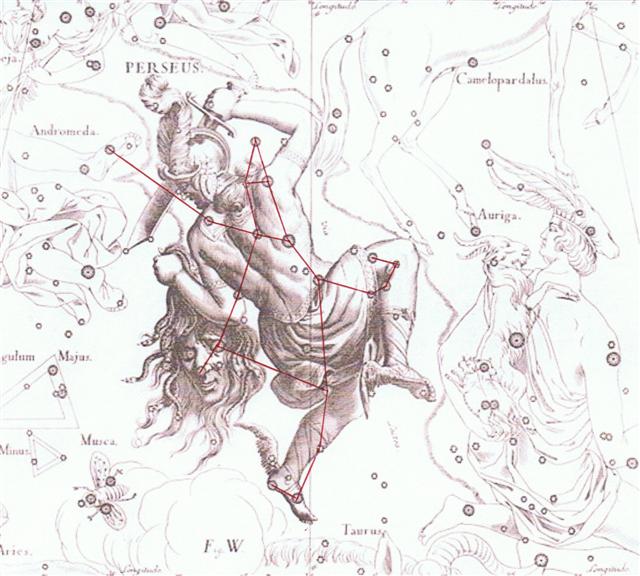Thus, a Sun 'year' with 260 days seems to have begun
when Denebola culminated at midnight 409 days after the March
equinox in the preceding year.
The Bharani
(Bearer) 'Fly' stretched
for 3 days, with its head at tagata in Cb1-14 and with niu
in its center. The Bharani star rose with the Sun 41.4 - 11.4 = 30 days after η Andromedae at
the back side of the Northern Fish:
|
'April 1
(91) |
2 |
3 |
4 (460) |
5 |
|
'October
1 (274) |
2 |
3 |
4 |
5 |
|
April 28 |
29 |
30 (120) |
May 1 |
2 |
|
October
28 (301) |
29 |
30 |
31 |
November
1 |
 |
 |
 |
 |
 |
|
Cb1-12 |
Cb1-13 |
Cb1-14 |
Cb1-15 |
Cb1-16 |
|
manu rere - kua rere ga manu - ki te ragi |
eaha te nuku erua |
koia kua huki |
e
niu tu |
ki
te ariki - e ka hua ra tona rima |
|
ν
Arietis (38.5) |
μ
Arietis (39.4),
Head of
the Fly
(39.6), Kaffaljidhma (39.8) |
ο
Arietis (40.0),
Angetenar (40.2),
Right
Wing
(40.9) |
Bharani-2 /
Stomach-17 |
no star
listed (42) |
|
π
Arietis (41.2),
BHARANI
(41.4),
τ² Eridan, σ Arietis (41.7) |
|
ρ Lupi (221.0),
Toliman (221.2), π
Bootis (221.8), ζ Bootis (221.9) |
31 Bootis (222.0), Yang
Mun (222.1), Rijl al Awwa (222.5), ο Bootis (222.9) |
Izar (223.0), 109
Virginis, α Apodis (223.3) |
Al
Zubānā-14a /
Visakha-16 /
Root-3 |
Kochab (225.0) |
|
ZUBEN ELGENUBI (224.2), ξ Bootis, ο Lupi
(224.5) |
|
'April 10 (100) |
11 |
12
(468) |
13 |
|
'October 10 |
11 |
12
(285) |
13 |
|
May
7 |
8 |
9 |
10
(130) |
|
November 6 (310) |
7 |
8 |
9 |
 |
 |
 |
 |
|
Cb1-21 (413) |
Cb1-22 |
Cb1-23 |
Cb1-24 |
|
hoea |
ko te rima |
kua oo ki te vai |
ma te ua |
|
ζ
Arietis (47.7) |
Zibal (48.0) |
τ
Arietis (49.7) |
Algenib Persei
(50.0), ο Tauri (50.2), ξ Tauri (50.8)
Gienah
|
|
Al Zubānā-14b |
μ Lupi, γ Tr. Austr.
(231.3) |
ο Cor. Borealis
(232.0), δ Lupi (232.1), φ¹, ν² Lupi (232.2), ν¹
Lupi (232.3), ε Lupi (232.4), φ² Lupi (232.5),
Pherkad (232.6), η Cor. Borealis (232.8), υ Lupi
(232.9) |
Alkalurops (233.1) |
|
χ Bootis (230.2), χ
Bootis (230.3), Princeps (230.6),
ZUBEN ELSCHEMALI
(230.8) |
|
'April 14 (104) |
15 |
16
(472) |
|
'October 14 |
15
(288) |
16 |
|
May 11 (131) |
12 |
13
(499) |
|
November 10 (314) |
11 |
12 |
 |
 |
 |
|
Cb2-1 |
Cb2-2 |
Cb2-3 (419) |
|
Eaha te honu kua tupu |
i to maitaki - o te hau tea |
te hono huki - maro |
|
no
star listed (51) |
no
star listed (52) |
no
star listed (53)
Acrux
|
|
Nusakan (234.0), κ¹
Apodis (234.3), ν Bootis (234.7)
|
θ
Cor. Borealis (235.3), γ Lupi (235.6), Gemma,
Zuben Elakrab, Qin, ε Tr. Austr. (235.7), μ Cor.
Borealis (235.8)
Sirrah
|
φ Bootis (236.2), ω
Lupi (236.3), ψ¹ Lupi (236.7), ζ Cor. Borealis
(236.9) |
The right side of heliacal Algenib Persei corresponded to
te honu kua tupu in Cb2-1, the 'earth turtle' who
was growing in the rays from the Sun.

In rongorongo times Gregorian day 314
could be seen close to the Full Moon.
In the times of Al Sharatain
'April 14 could be understood as 1 more than 4-13 (with
413 = 14 * 29½). The light from the Sun was reflected on
the face of the Moon and therefore 413 could be
perceived as 314 reversed.
Glyph 413 was hoea and Misam (κ
Persei) was at the elbow of the grasping left arm of the
hero.
|
Egyptian hand |
 |
Phoenician kaph |
 |
Greek
kappa |
Κ (κ) |
|
Kaph
is thought to have been derived from a
pictogram of a hand (in both modern
Arabic and modern Hebrew, kaph
means palm/grip) ...
... The manik, with the tzab,
or serpent's rattles as prefix, runs
across Madrid tz. 22 , the figures in
the pictures all holding the rattle; it
runs across the hunting scenes of Madrid
tz. 61, 62, and finally appears in all
four clauses of tz. 175, the so-called
'baptism' tzolkin. It seems impossible,
with all this, to avoid assigning the
value of grasping or receiving. But in
the final confirmation, we have the
direct evidence of the signs for East
and West. For the East we have the glyph
Ahau-Kin, the Lord Sun, the Lord
of Day; for the West we have
Manik-Kin, exactly corresponding to
the term Chikin, the biting or
eating of the Sun, seizing it in the
mouth.



The
pictures (from Gates) show east, north,
west, and south; respectively (the lower
two glyphs) 'Lord' (Ahau) and
'grasp' (Manik).
Manik was the 7th day sign of the
20 and Ahau the last
... |
|










